2010 AUDI S6 emergency towing
[x] Cancel search: emergency towingPage 5 of 368

Table of contents
Monitoring the Advanced Airbag Vehicle care .............. 258 Emergency towing with
System ...................... 206 commercial tow truck ........ .
Side airbags ... ......... ...... 211
Cleaning and protection ...... 258 Lift
ing vehicle ............... . 334
336
Side curtain airbags . . . . . . . . . . . . 214
Child Safety .. .. .......... ..... 217
Important things to know . . . . . . 217
Child safety seats . . . . . . . . . . . . . 222
Installing a child safety seat .. .. 227
LATCH Lower anchorages and
tethers for children . . . . . . . . . . . . 230
Additional Information 237
Vehicle operation ...... 240
Intelligent technology ........ 240
Notice abou t data recorded by
vehicle control modules . . . . . . . . 240
E lectronic Stabilization Program
(ESP) ........................ 240
Braking ...................... 243
Servo tronic® -advanced power
steering system . . . . . . . . . . . . . . . 245
Driving with your quattro® . . . . . . 246
Energy management ........... 247
Driving and environment ...... 249
The first 1,000 miles (1,500 km)
and afterwards . . . . . . . . . . . . . . . 249
Avoid damaging the veh icle . . . . . 250
Driving through water on roads . 250
Catalytic converter . . . . . . . . . . . . 250
Operate your vehicle economically
and minimize pollution ......... 251
Trailer towing ................. 254
Driving with a trailer . . . . . . . . . . . 254
T railer towing tips . . . . . . . . . . . . . 256
Controls and equip
ment Safety first
General informa
tion . . . . . . . . . . . 258
Care of exterior . . . . . . . . . . . . . . . 258
Care of interior . . . . . . . . . . . . . . . 265
Fuel supply and filling your fuel
tank ..........................
271
Gasoline . . . . . . . . . . . . . . . . . . . . . 271
Fuel tank . . . . . . . . . . . . . . . . . . . . . 272
Checking and filling . . . . . . . . . . . 276
Technical data
General information
Explanation of technical data .. .
Vehicle ident ification ......... .
Weights ................... . .
Dimensions ............... .. . 338
338
338
338
339
339
Engine hood . . . . . . . . . . . . . . . . . . 276
Data . . . . . . . . . . . . . . . . . . . . . . . . . . 341
Engine oil . . . . . . . . . . . . . . . . . . . . 279 300 hp, 3.0 liter, 6-cylinder
Engine cooling system . . . . . . . . . 284
Brake fluid . . . . . . . . . . . . . . . . . . . 287
Ba ttery . . . . . . . . . . . . . . . . . . . . . . 288
Windshield/headlight washer container . . . . . . . . . . . . . . . . . . . . 292
Tires and wheels . . . . . . . . . . . . . . 293 engine ......................
.
265 hp, 3.2 liter , 6-cylinder
engine ......... ..... ........ .
350 hp, a-cylinder engine ..... .
Consumer Information ...... .
Warranty coverages .......... . 341
342
343
344
344
T ires ........................ 293 Operating your vehicle outside the
T ire pressure monitoring system 312
Do-it-yourself service . 316
What do I do now? ........... 316
Trunk escape handle ........... 316
Jack, tools and spare wheel ..... 316
Changing a wheel . . . . . . . . . . . . . 318
Fuses and bulbs . . . . . . . . . . . . . . 325
F u ses ........... ............. 325 U.S.A
. or Canada ............. .
Audi Service Repair Manuals and
Literature ................... .
Maintenance ................ .
Additional accessories, modifications and parts replacement ............... . .
Declaration of Compliance,
T elecommunications and
Electronic Systems .......... . .
Bulbs ........................ 329
Alphabetical index ....
Emergency situations ......... 331
General . . . . . . . . . . . . . . . . . . . . . . 331
Starting by pushing or towing 331
Starting with jumper cables .... 331
Use of jumper cables . . . . . . . . . . 332
Vehicle operation Vehicle care Do-it-yourself service
344
344
344
346
347
350
Technical data
Page 64 of 368
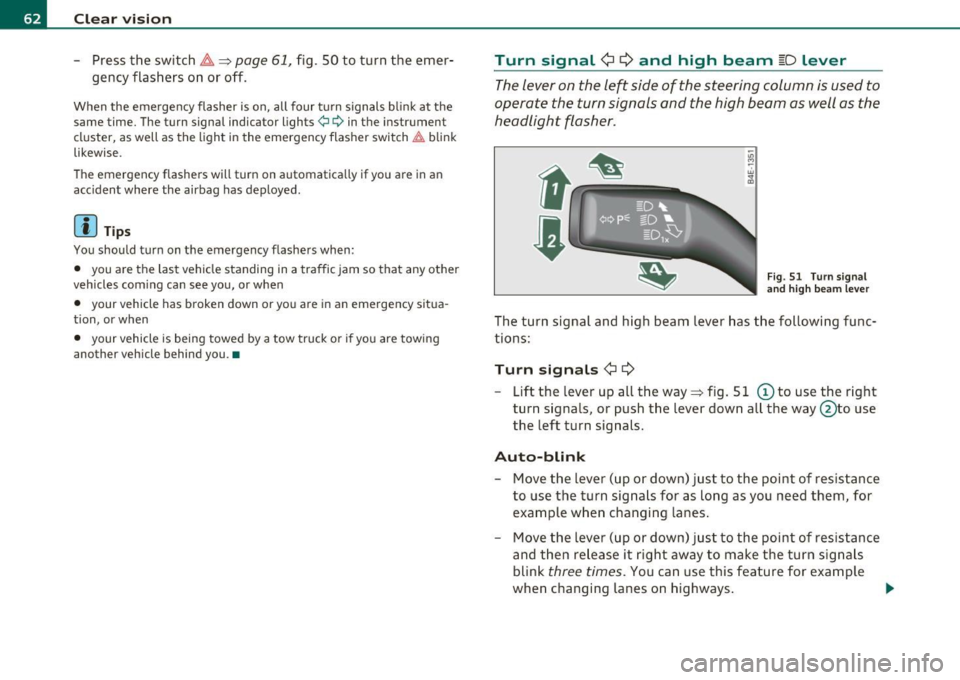
Clear vision
-Press the switch /4. => page 61, fig. SO to turn the emer-
gency flashers on or off.
When the emergency flasher is on, all four turn signals blink at the
same time. The turn signal indicator lights¢¢ in the instrument
cluster, as well as the light in the emergency flasher switch~ blink
likewise.
The emergency flashers will turn on automatically if you are in an accident where the airbag has deployed.
(I) Tips
You should turn on the emergency flashers when:
• you are the last vehicle standing in a traffic jam so that any other
vehicles coming can see you, or when
• your vehicle has broken down or you are in an emergency situa
tion, or when
• your vehicle is being towed by a tow truck or if you are towing
another vehicle behind you .•
Turn signal ¢ c> and high beam ~D lever
The lever on the left side of the steering column is used to
operate the turn signals and the high beam as well as the
headlight flasher .
i
'
-to
"' -w
"' cc
Fig. 51 Turn signal
and high beam lever
The turn signal and high beam lever has the following func
tions:
Turn signals ¢ Q
- Lift the lever up all the way=> fig. S 1 © to use the right
turn signals, or push the lever down all the way@to use
the left turn signals.
Auto-blink
-Move the lever (up or down) just to the point of resistance
to use the turn signals for as long as you need them, for
example when changing lanes.
- Move the lever (up or down) just to the point of resistance
and then release it right away to make the turn signals
blink
three times . You can use this feature for example
when changing lanes on highways.
~
Page 85 of 368
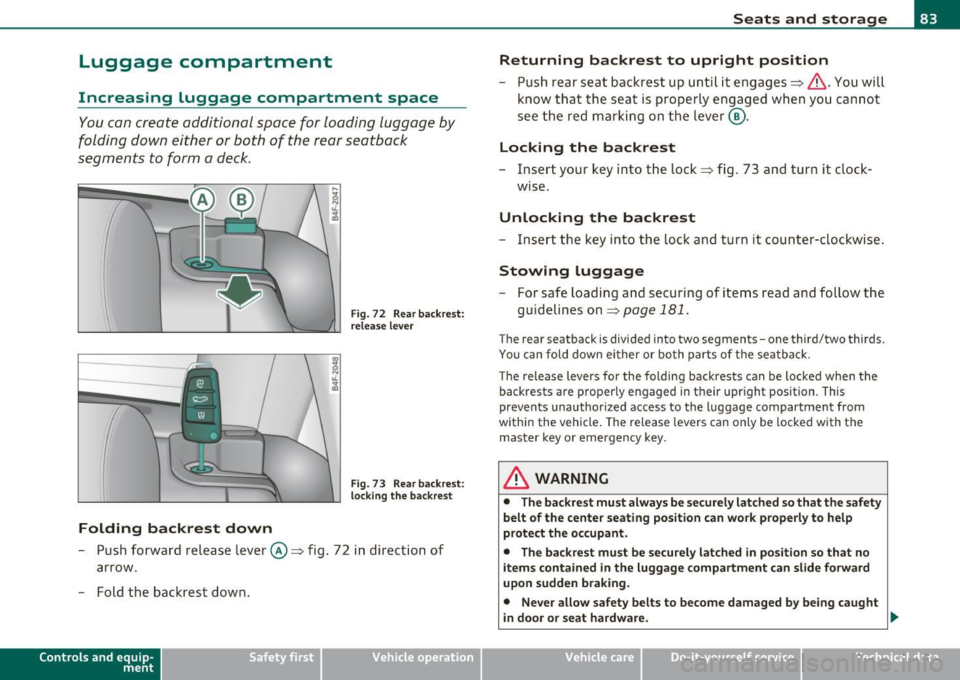
Luggage compartment
Increasing Luggage compartment space
You can create additional space for loading luggage by
folding do wn either or both of the rear seatback
segments to form a deck .
Folding backrest down
Fig. 72 Rear backr es t:
rele ase lever
Fig. 73 Rea r ba ckr est:
l o cki ng t he b ackre st
- Push forwa rd release lever ©~ fig. 72 i n direction of
arrow.
- Fold the backrest down .
Contro ls a nd e quip
m en t Vehicle
OP-eration
Seats and storage
Returning backrest to upright position
- Push rear seat backrest up unti l it engages~ &. You will
know that the seat is properly engaged when you canno t
se e t he red marking on the lever @.
Locking the backrest
- Insert your key into t he lock ~ fig . 73 and turn it clock
w ise.
Unlocking the backrest
- Ins ert the key in to the lock and turn it count er-clockwise .
Stowing luggage
-For safe loading and securing of items read an d follow the
guidelines on~
page 181.
The rear seatback is divided into two segments -one third/two thirds.
You can fold down ei ther or bo th parts of t he sea tback.
T he release levers for the fo lding backrests can be loc ked when the
back rests are properly engaged in their upr ight position. This
prevents unauthor ized access to the luggage compartment from
withi n the vehicle. The release levers can only be locked with the
master key o r emergency key.
& WARNING
• The backr est must always be s ecurely latched so that the sa fety
belt of the center seating position can work properly to help
prote ct the occupant .
• The backrest must be securely latched in position so that no
items contained in the luggage compartm ent can s lide forward
upon sudden b raking.
• Never allow safety belts to become damag ed by being caught
in d oor or seat hardware. _,.
Vehicle care Do-it-yourselt service iTechnical data
Page 320 of 368

,.,___W_ h _a_t _ d _ o_ I_ d_ o_ n_o _w_ ? ____________________________________________ _
- Disengage and lower the floor panel before you close the
luggage compartment lid again.
Storing the replaced wheel
-Place the replaced wheel inside the spare wheel well in the
luggage compartment.
Tighten the knurled retaining screw clockwise to secure
the wheel in place.
- Disengage and lower the floor panel before you close the
luggage compartment lid again.
& WARNING
Loose items in the passenger compartment can cause serious
personal injury during hard braking or in an accident.
• Never store the spare wheel or jack and tools in the passenger
compartment.
• Always store all jacking equipment, tools, and the spare wheel
in the luggage compartment.
• Tighten the knurled retaining screw for the spare wheel
securely.
[ i] Tips
Check the inflation pressure of the spare tire periodically to keep the
tire ready for use.•
Changing a wheel
Before changing a wheel
Observe the following precautions for your own and your
passenger's safety when changing a wheel.
- After you experience a tire failure, pull the car well away
from moving traffic and try to reach
level ground before
you stop :::> & .
- All passengers should
leave the car and move to a safe
location (for instance, behind the guardrail) :::>& .
- Engage the
parking brake to prevent your vehicle from
rolling unintentionally:::> &.
- Move
selector lever to position P :::> & .
- If you are towing a trailer: unhitch the trailer from your
vehicle.
- Take the
jack and the spare tire out of the luggage
compartment:::>
page 316.
& WARNING
You or your passengers could be injured while changing a wheel if
you do not follow these safety precautions:
• If you have a flat tire, move a safe distance off the road. Turn
off the engine, turn the emergency flashers on and use other
warning devices to alert other motorists.
• Make sure that passengers wait in a safe place away from the
vehicle and well away from the road and traffic.
• To help prevent the vehicle from moving suddenly and possibly
slipping off the jack, always fully set the parking brake and block
the wheel diagonally opposite the wheel being changed. When
one front wheel is lifted off the ground, placing the Automatic
~
Page 333 of 368
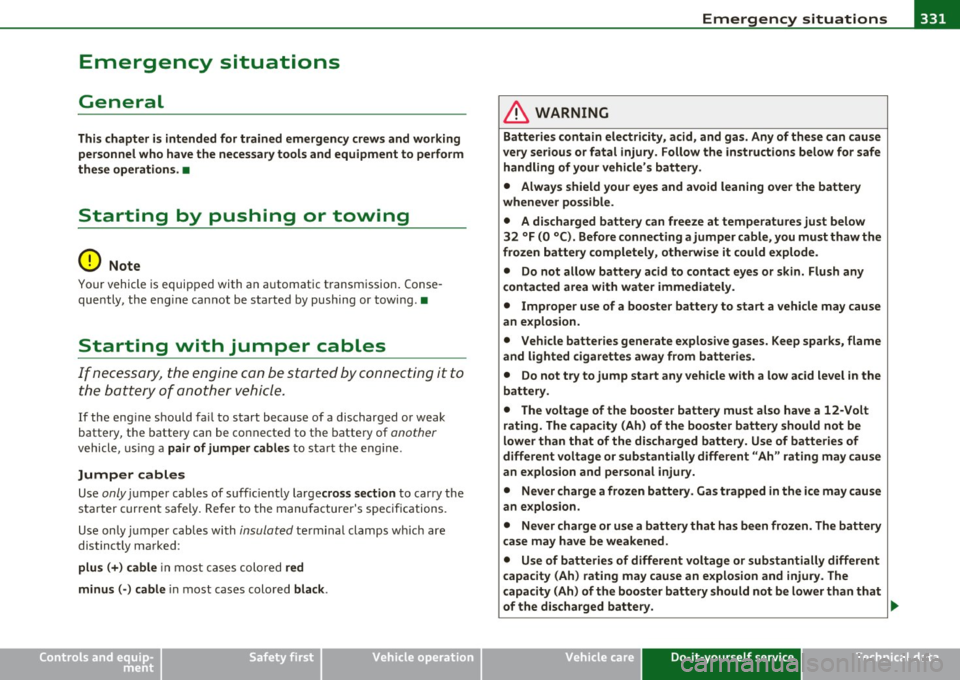
Emergency situations --------------=----EWI
Emergency situations
General
This chapter is intended for trained emergency crew s and working
personnel who ha ve the necessar y tools and equipment to perform
the se operations . •
Starting by pushing or towing
(D Note
Your vehicle is equipped with an a utomat ic transmission. Conse
que ntly, the eng ine can not be started by pushing or towing. •
Starting with jumper cables
If necess ary, the engine can be started by connecting it to
the battery of an other vehicle .
If the engine shou ld fai l to start because of a discharged or weak
battery, the battery can be co nnecte d to the battery of
another
vehicle, using a pair of jumper cable s to start the engine .
Jumper cables
Use only jumper cables of suffic ient ly large cross section to carry the
sta rter cur ren t safely . Refe r to the manufacture r's specifications.
Use on ly j umper cab les with
insulated te rm ina l clamps w hich are
distinct ly marked :
plus(+) cable in most cases colo red red
minus (-) cable i n most cases colored black.
Safety first
& WARNING
Batterie s contain electricity, acid, and gas . Any of these can cause
very serious or fatal injury . Follow the inst ructions below for safe
handling of your vehicle 's battery .
• Always shield your eyes and avoid leaning over the battery
whenever possible.
• A discharged battery can freeze at temperatures just below
32 °F (0 °C). Before connecting a jumper cable, you must thaw the
frozen battery completely , otherwise it could explode.
• Do not allow battery acid to contact eyes or skin . Flush any
contacted area with water immediately .
• Improper use of a booster battery to start a vehicle may cause
an explosion.
• Vehicle batteries generate e xplos ive gases. Keep spa rks, flame
and lighted cigarettes away from batteries.
• Do not try to jump start any vehicle with a low acid level in the
battery.
• The voltage of the booster battery must also h ave a 12 -Volt
rating. The capacity (Ah) of the booster battery should not be
lower than that of the discharged battery. Use of batter ies of
different voltage or sub stantially different "Ah " rating may cau se
an explosion and personal injury.
• Never charge a frozen battery . Ga s trapped in the ice may cause
an e xplosion.
• Never charge or use a battery that has been frozen. The battery
case may have be weakened.
• Use of batteries of different voltage or substantially different
capacity (Ah ) rating may cause an explosion and injury . The
capacity (Ah ) of the booster battery should not be lower than that
of the discharged battery. _..
Vehicle care Do-it-yourself service Technical data
Page 336 of 368
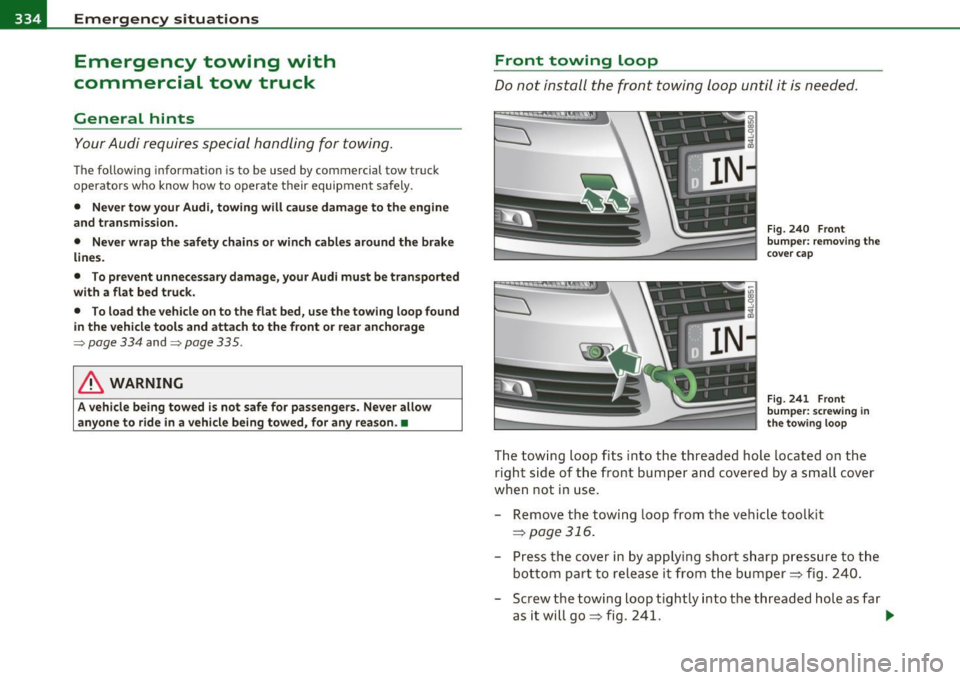
,..,___E_ m_ e_r -=g :.. e_ n_c -=y '-- s_i_t _u _a _ t_ i_ o _ n_ s ____________________________________________ _
Emergency towing with
commercial tow truck
General hints
Your Audi requires special handling for towing.
The following information is to be used by commercial tow truck
operators who know how to operate their equipment safely.
• Never tow your Audi, towing will cause damage to the engine
and transmission.
• Never wrap the safety chains or winch cables around the brake
lines.
• To prevent unnecessary damage, your Audi must be transported
with a flat bed truck.
• To load the vehicle on to the flat bed, use the towing loop found
in the vehicle tools and attach to the front or rear anchorage
~ page 334 and~ page 335 .
& WARNING
A vehicle being towed is not safe for passengers. Never allow
anyone to ride in a vehicle being towed, for any reason. •
Front towing Loop
Do not install the front towing loop until it is needed.
Fig. 240 Front
bumper: removing the
cover cap
Fig. 241 Front
bumper: screwing in
the towing loop
The towing loop fits into the threaded hole located on the
right side of the front bumper and covered by a small cover
when not in use.
- Remove the towing loop from the vehicle toolkit
=> page 316.
-Press the cover in by applying short sharp pressure to the
bottom part to release it from the bumper=> fig. 240.
- Screw the towing loop tightly into the threaded hole as far
as it will go=> fig. 241 . ..,
Page 337 of 368
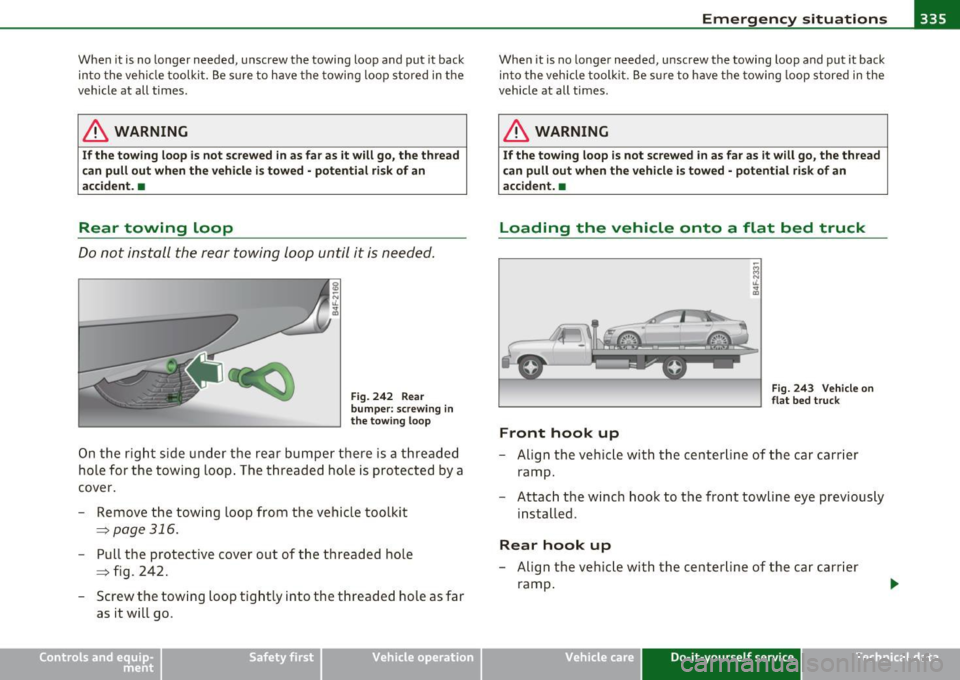
Emergency situations --------------=---:.--___.VPII
When it is no longer needed, unscrew the towing loop and put it back
into the vehicle toolkit. Be sure to have the towing loop stored in the
vehicle at all times .
& WARNING
If the towing loop is not screwed in as far as it will go, the thread
ca n pull out when the vehicle is towed -potential risk of an
accident. •
Rear towing loop
Do not install the rear towing loop until it is needed.
Fig. 242 Rear
bumper: screwing in
the tow ing loop
On the right side under the rear bumper there is a threaded
hole for the towing loop. The threaded hole is protected by a
cover.
- Remove the towing loop from the vehicle toolkit
=::;, page 316.
-Pull the protective cover out of the threaded hole
=;, fig. 242.
-Screw the towing loop tightly into the threaded hole as far
as it will go.
Vehicle OP-eration
When it is no longer needed, unscrew the towing loop and put it back
into the vehicle toolk it. Be sure to have the towing loop stored in the
vehicle at all times.
& WARNING
If the towing loop is not screwed in as far as it will go, the thread
c an pull out when the vehicle is towed · potential risk of an
accident. •
Loading the vehicle onto a flat bed truck
Front hook up
Fig. 243 Vehicle on
fl at bed truck
-Align the vehicle w ith the centerline of the car carrier
ramp.
- Attach the winch hook to the front towline eye previously
installed.
Rear hook up
- Align the vehicle with the centerline of the car carrier
ramp .
Vehicle care Do-it-yourself service iTechnical data
Page 356 of 368

-Alphabetical inde x ------',.__ ___________________________________ _
Driv ing messages ...... ...... .. .. .. .. 24
Dr iv ing safely . . . . . . . . . . . . . . . . . . . . . . 1 7 4
Dr iving through water ... ... ... .. .. .. 250
Dr iv ing time .. ............ .......... 34
Duplica te key . .... .... .. .. .. ........ 3 7
Dust fi lter
Climate controls .. .. .. .... .. .. . ... 96
DVD player for navigation system . .. . .. . 86
Dynam ic shift program ............ .. 156
E
Easy entry feature . .. .. .. .. .... ..... 108
Electric seat adjustment
See Power seat ................... 76
Electromechanical parking brake Emergency braking . ... .. .. .... .. . 11 5
Ma lf u nct ion . . . . . . . . . . . . . . . . . . . . . 115
Operation . . . . . . . . . . . . . . . . . . . . . . 113
Park ing .................... .. .. 114
Releasing and app ly ing ... .. ... .. .. 113
Starting off w ith a t railer ......... . 115
Wa rning/ind icator lights . .. .... .. .. 17
Electronic differential lock (EDL) How the system works ... ......... 241
Warning/ind icator lights . .......... 17
Electroni c immobili ze r ... .... .. .. .. .. . 40
Electronic powe r control
(EPC) war ning/ indicato r light .. .. ... . 14
E lectronic speed limiter ........ .... .. . 23
Ele ctro nic s tabiliza tion p rogram ( ESP)
How t he system wor ks ... ......... 2 40
W arning/ind icator lights . .......... 14 Emergency braking
..... .. .. .. .. .. .. 115
Emergency closing Power su nroof ... ... .. .. . ... ... 55, 56
Eme rgency flasher ................ ... 61
Wa rning/ind icator l ights . .. .. .. .. .. 15
Emergency locking of doors . .. .. .. .. .. 45
E mergency sta rt ing .... ..... ... .. .. . 331
Emergency towing .................. 334
Energy management ................ 247
Battery power .. .. .. .. .. .... ..... 248
Dr iver not ification ............... . 248
Engine Compartment . ... .. .. .. .. .. .. ... 2 78
Coolant .. ... .. .. .. .. .... .. .. .. . 284
Hood . ... .. .. .. .... ... .. .. .. .. . 276
Starting ....... .. .. ........ . 108, 109
Starting with jumpe r cab les . .. .... . 331
Stopping ...... .............. ... 110
E ngine compa rtment
Sa fety instructions . .... ... .. .. .. . 277
Working the eng ine compartment .. 277
En gine coolant system ........ .. .. .. . 28 4
Add ing coolant ................. . 285
C hecking coo la nt level . ..... .. .. .. 28 4
Checking the engine coo lant level . .. 284
Ma lfu nction ... .. ..... ..... .... .. . 27
Radiator fan ....... .. ... . .. .. ... 286
E ngine coo lant tempe rature
T emperat ure gauge ............. .. . 8
Engine data ....... ...... .... .. ..... 341
Engine hood Closing .... ..... ..... .... .. .. .. . 2 77
How to re lease the hood ..... .. ... . 2 76 Engine oil
.. ... .... ... .. . ... ... .. .. 279
Add ing .............. .... ... .. .. 282
Add itives .................. .... . 282
Changing .. ..... .......... .. .. .. 283
Checking the engine oil leve l ..... .. 281
Indi cat io ns and conditions requiring extr a
check ing . .. .. .. .. ............. 281
Oil consumption .... ............. 280
Oil grades . .. .. .... ..... ....... . 279
Recommended oil check intervals ... 281
Specification and viscosity ..... .. .. 279
Engine oil leve l .... .. .. ............. . 31
E ngine oil p ress ure
Mal fu nct ion .. .. .. .. .... .......... 28
Engine oil sensor defect ive . ...... ... .. 31
Engine speed limitation ....... ... .. .. . 32
E nvironmen t
Bre ak-in per iod ...... ...... .. .. .. 249
Ca taly tic converte r .. .... ......... 250
Disposing o f you r vehi cle bat tery .... 292
Driving at hig h speeds ..... ... . ... 252
Driving to minimize poll ution and noise . .
2 51
Fuel .. .. .... ....... ...... .... .. 273
F ue l economy .. .. .. ....... .. .. .. 251
Leaks unde r yo ur vehicle ... .. .. .. . 2 77
Lett ing the vehicle stand and warm up .. .
252
Proper disposa l of dra ined brake fluid 287
Prope r disposal of dra ined engine coo la nt
285
Proper disposal of drained engine oil 282, 283
Recy cling used e ng ine o il .......... 282